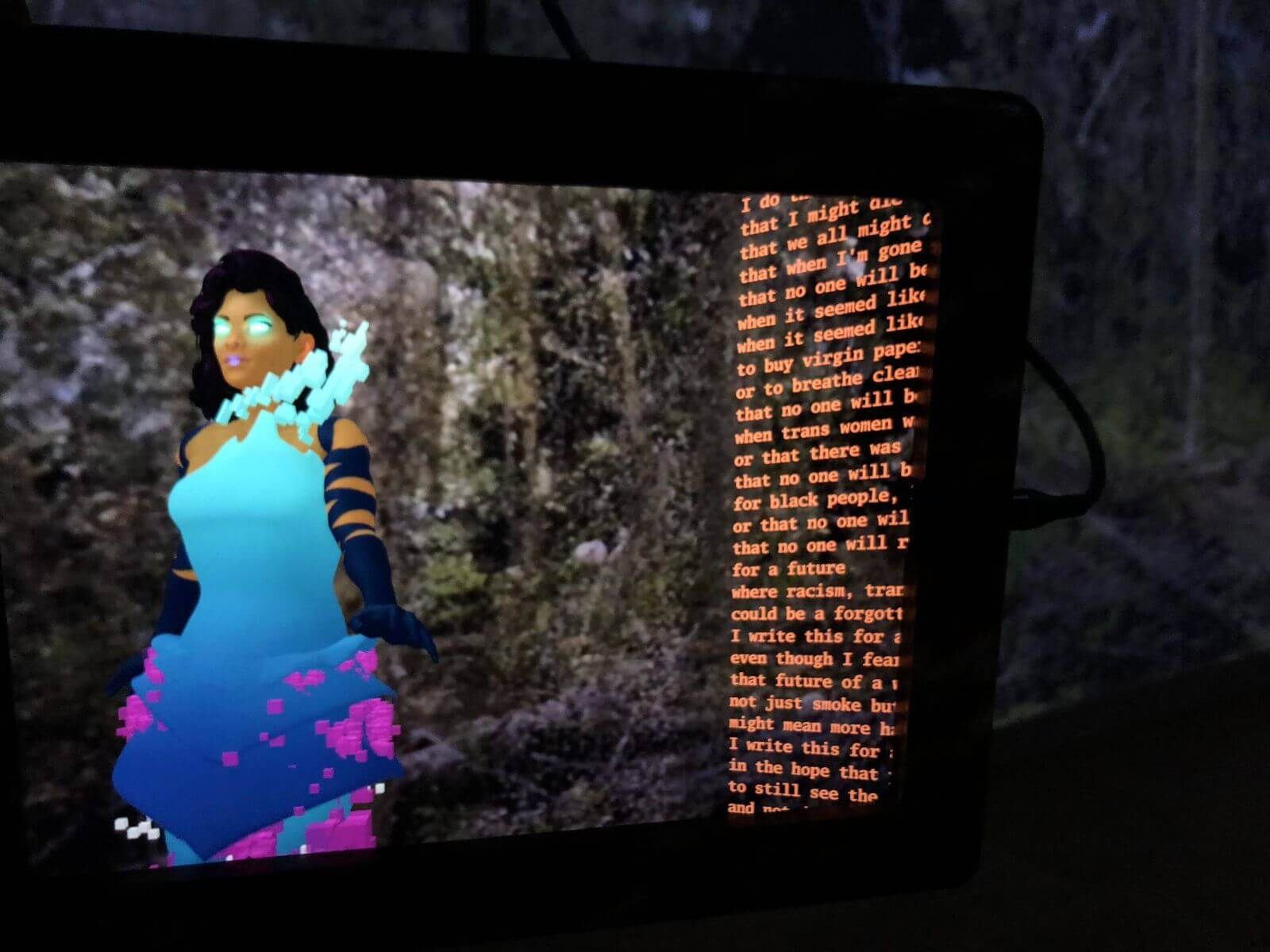Interview by Allan Gardner
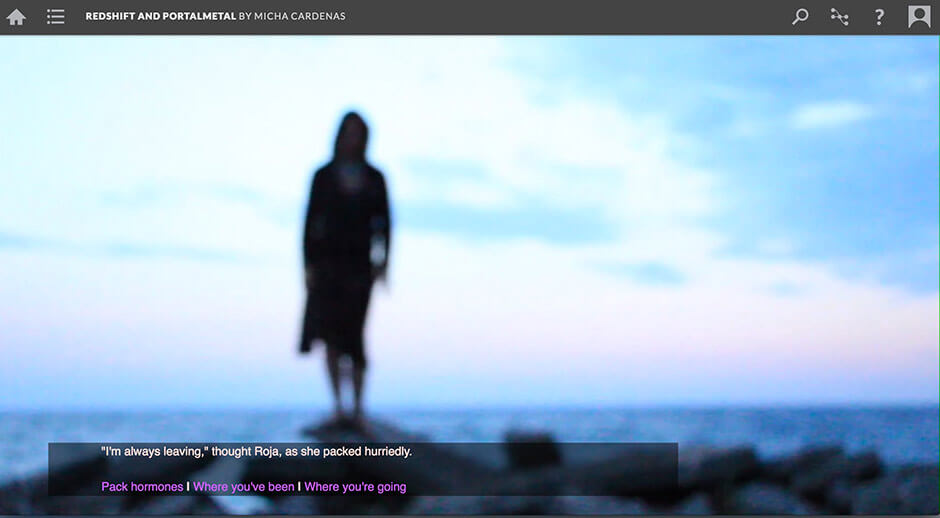
micha cárdenas is an artist, theorist, poet and assistant professor at UC Santa Cruz working with the algorithms and poetics of trans people of colour. She is a first-generation Colombian American, having earned her PhD in Media Arts + Practice in the School of Cinematic Arts at the University of Southern California, and she is a member of the artist collective Electronic Disturbance Theater 2.0.
Her solo and collaborative artworks have been presented in a variety of institutions, including the Museum of Modern Art in New York, the ZKM in Karlsruhe, and the Art Gallery of Ontario in Toronto. Her artworks have been referred to as “A seminal milestone for artistic engagement in VR” (Spike, Berlin) and “nothing less than a practical theory of desire that creates livable, affirmative worlds that resist the violence of capitalism and heteronormativity” (Zach Blas, Artist, Author and Lecturer at Goldsmiths University).
As a member of the Electronic Disturbance Theatre 2.0/B.A.N.G. LAB, cárdenas was part of the production of the artwork/activist app Transborder Immigration Tool. The app was designed to provide people of all nationalities with the necessary information to increase safety during desert travel, directing users towards water as well as functioning as a compass. EDT member Amy Sara Carroll contributed poems, which would play at random through the app in a series of different languages. The aim of this seemingly is to help users feel connected to and supported by other human beings. Each poem refers, sparse in nature, to the beauty & resources of the desert, as well as survival itself.
The project found criticism from the right, including Glenn Beck, who said it would Destroy the US Border with poetry. EDT member Ricardo Dominguez concurred with this statement. By 2011, the app was ready for distribution in Mexico. However, at this time, the Cartels had taken control of all unofficial border crossings. It was deemed too dangerous for potential users to distribute, so it continues to exist as a marker of empathy and an indication of how quickly situations may deteriorate through inaction.
Part of what makes cárdenas’ work so valuable is this desire to close gaps, even playing fields and generate understanding. When media reaction to this particular project referred to the people it was designed to help as potentially being “illegals”, it existed as proof of the dehumanisation migrants faces. Its necessity was made clear through the media reaction. It confirmed how essential it is that through contemporary technology and education, we try to meet these issues directly. If traditional media has been corrupted, then we must adapt and create/utilise technologies accessible outside of this, a sentiment triggered within empathetic individuals – encouraging direct action and contribution.
Currently working on her new book, entitled Poetic Operations, cárdenas proposes algorithmic analysis to develop a trans of colour poetics. In the interview below, we have a chance to learn more about the production of this new text, including its relationship to Glissant’s Poetics of Relation and the definition of Operations within the context of the algorithmic analysis of contemporary trans of colour poetics.
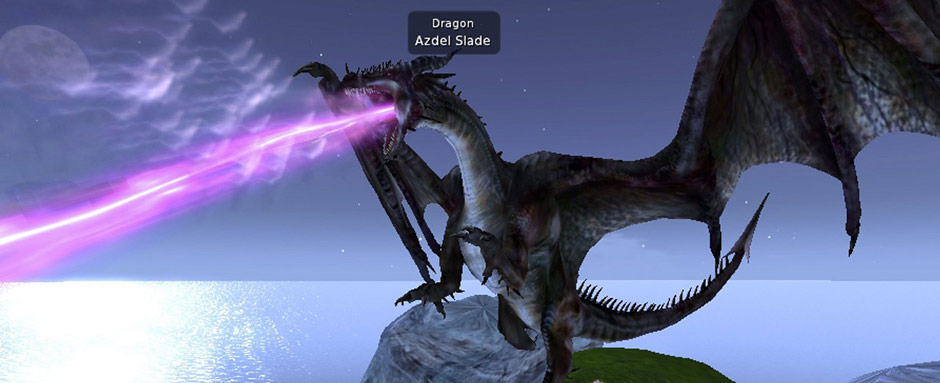
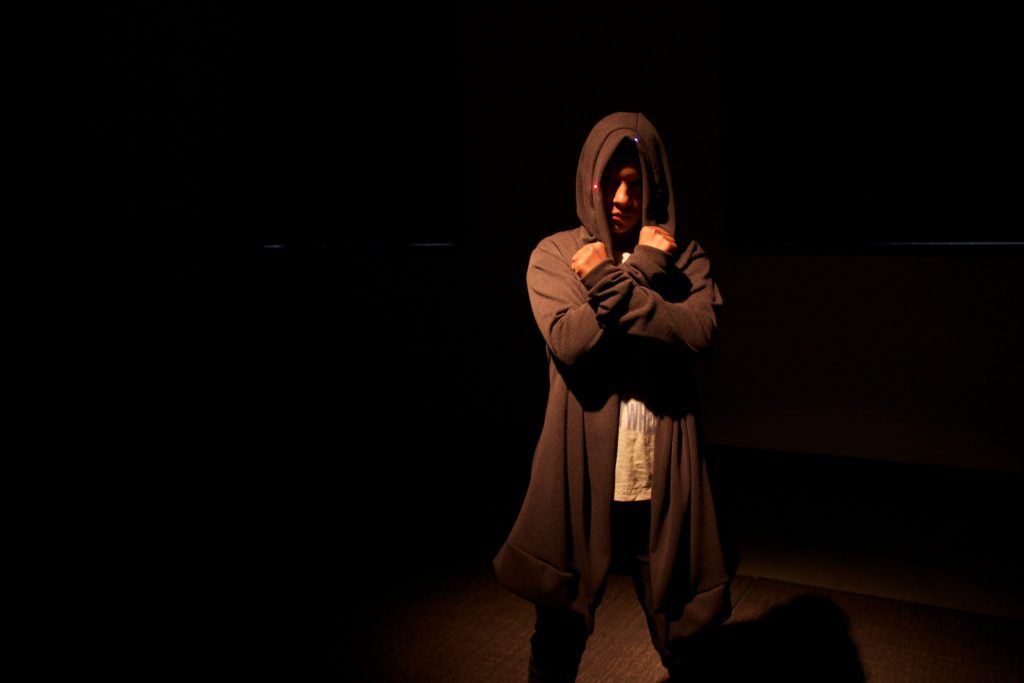
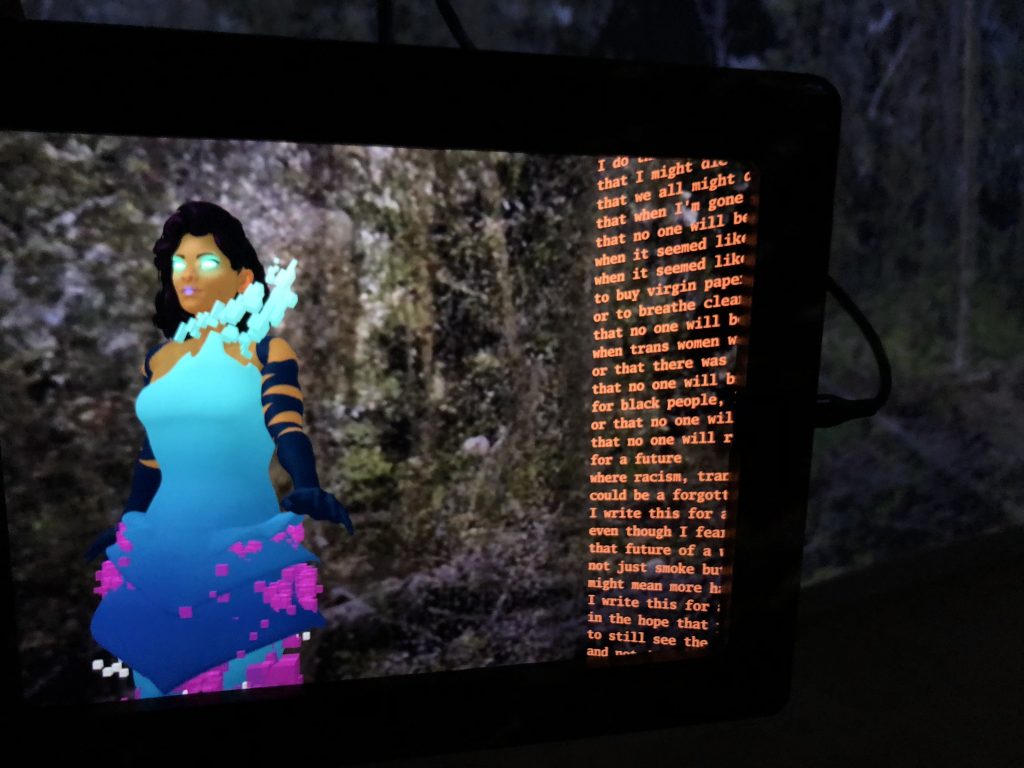
Right: Sin Sol, Forest Memory, Henry Art Gallery Seattle, micha cárdenas, Abraham Avnisan, Morgan Thomas, Adrian Phillips, Marcelo Viana Neto and Wynne Greenwood (2018)
Pregnancy, a poetry/bioart project, presents a vision of trans Latina reproductive futures, based on your experiences of cryogenic tissue banking(or sperm banking) after having been on hormones for many years. Being your practice prominently based on new media imagery, why did you decide to go for a written representation of a poem?
Pregnancy consists of poems, images and videos. It has been presented in galleries and museums as a video, and in print as photos and text. The images are from videos I made of my own biological material. I was documenting my body fluids and using a microscope to look for the presence of sperm, monitoring over time as my reproductive capacities changed from stopping my hormones.
The choice to only represent my body through images under a microscope had multiple meanings. In one sense, it was a refusal to show depictions of my body as a gesture of refusing the voyeuristic gaze that cisgender audiences use to see work by transgender audiences.
Even well-meaning audiences often want to know the “truth” about trans people’s bodies, to feel solidarity with us, which can still be an intrusive gesture and a denial of the right of transgender people to have boundaries or privacy. In another sense, it is a way of highlighting this same dynamic, where my body is literally “under the microscope” for the audience to look at.
When it was presented at the Henry Art Gallery Museum in Seattle, as part of the Chris Vargas’ Museum of Transgender History and Art exhibition, the curator Nina Bozicnik had the brilliant idea to put the video screen on a table surface so that the audience had to literally look down, emulating the gesture of looking in a microscope.
I presented the poems in the video alongside images so that the audience could read about my experiences or the experiences of the narrator in those poems. Poetry has long been a form that has been important to my work as a multilayered space to stitch together multiple registers of feeling, though, narrative and experimentation.
For that project, I had stopped taking my prescribed hormones, so part of the project was reflecting on the way that my usage of language changed as a result. I did not edit the poems after resuming my correct hormone dosage, even though I would use different language now to describe those events.
In Poetic Operations, your book is in progress. Some parts revolve around ‘the stitch’. For our audience that is not familiar with it, could you tell us the intellectual process behind this concept?
The stitch is an operation of trans of colour poetics, both material and a conceptual gesture, of binding two things together with a third. Poetic Operations (PO) takes significant inspiration from Édouard Glissant’s Poetics of Relation, in which he describes the poetics of the decolonial space of the Caribbean, understanding the relationship between islands and peoples as a basis for poetics. In PO, I articulate and demonstrate the method of algorithmic analysis, which includes breaking problems down into their underlying operations.
The idea of operations can be seen in code, or mathematics, with an operator like the + symbol, which adds two numbers together. I am inspired by the way that media theorists have used the operations described in Gilles Deleuze and Felix Guattari’s process ontology, such as the operation of the cut.
From there, I identify new operations used by trans of colour artists including the stitch and the shift. I describe artworks such as Giuseppe Campuzano’s De Natura Incertus, a modified Peruvian national ID card, and my own Local Autonomy Networks, a wearable electronic network.
In these artworks, one can see stitching in many forms, from the stitching of circuits into clothing, to the digital stitching of images together, to the stitching together of lines or blocks of code. As you mention and thank you for your question with its personal dimension, the stitch has additional layers of meaning for trans people who choose to undergo surgery. I propose the stitch as one operation in a trans of colour poetics of media and performance.
What are the challenges of redefining gender we are facing nowadays, and how digital interfaces and altered realities can play a positive role in it?
There is an increasing understanding that the Western binary gender system is a colonial system that must be dismantled. In Black on Both Sides (2017), C. Riley Snorton makes this argument, and it was also articulated by Gloria Anzaldúa in Borderlands/La Frontera (1987) when she writes “I know things older than gender.”
Digital interfaces today often preclude non-binary and non-Western expressions of gender or capitalize on them, but scholars such as artist/theorist Sandy Stone have described how earlier interfaces such as text-based Multi-User Dungeons allowed for a wider range of gender expression by allowing or requiring users to describe their appearance and gender with text.
In The Transreal (2012), I describe how there are multiple similarities between the transgender experience and the experience of using multiple realities, such as augmented reality, mixed reality and alternate reality games. I propose that artists working with multiple realities can learn from the experiences of trans people, such as inhabiting new bodies and having multiple identities, sometimes simultaneously.
From programmable matter, augmented and virtual realities, 3D/4D printing biological design, and unthinkable human interaction with digital interfaces, the material seems to be more and more blending with the digital. Where do you think we are headed in terms of this new digital materialism?
Advances in augmented reality, such as the Magic Leap, point to a very near and exciting blending of realities. Seen alongside efforts by Apple and Google to incorporate augmented reality into devices that many people use everyday, it appears to me that a future of everyday life as a space of mixed reality, where virtual objects exist among and alongside physical objects, is very near.
There are also many aspects of this to be concerned regarding this encroachment into our personal spaces, with the way that social media is designed for addiction and surveillance. From the absolutely objectified virtual girlfriend in Blade Runner 2049 to the calming virtual plants seen in Seedling on Magic Leap, these objects require even more dependence on algorithms and AI, and every cycle they are drawn presents an algorithmic opportunity for surveillance and data collection.
What do you think about the biotechnological and biopolitical domination of our bodies in the current times?
In 2019, the biotechnological and biopolitical domination of bodies continues to fall along colonial lines, with people of colour, trans, gender non-conforming and queer people, being subject to extreme bodily surveillance, violence and murder on a daily basis.
While wealthy people in global north countries purchase devices marketed as entertainment and social status upgrades purchase devices such as the Apple Watch to introduce the kind of constant, finely granulated surveillance that Deleuze and Guattari described as molecular. Still, domination is being met with resistance from artists and activists alike who are inhabiting and imagining bodies that exceed the algorithms’ abilities to categorize and capture, such as in the work of Zach Blas, Morehshin Allahyari and Lee Blalock.
Mary Magicc’s “Housewives Making Drugs” demonstrates methods of biotechnological subversion to escape the control of cis-heteronormative forms of domination by the medical-industrial complex. Pinar Yoldas’ work continues to imagine bodies beyond today’s biotechnological configurations in ways that point to the urgency of climate activism, such as her imaginary animal species grown out of the pacific trash vortex in “Ecosystem of Excess”.
What directions do you see taking your work into?
My current research is in finishing my book Poetic Operations and developing an augmented reality game Sin Sol / No Sun. Poetic Operations looks at digital media art by trans and gender non-conforming people of colour in order to propose algorithmic analysis as a way of extending intersectional analysis.
By analyzing my own artworks, as well as artworks by artists including Mattie Brice, Janelle Monáe and Giuseppe Campuzano, the book describes a trans of colour poetics, a poetics of shifting identities and stitching communities. Building on the inspiring work of scholars such as Safiya Umoja Noble, Édouard Glissant and Kara Keeling, I describe how algorithms work in these digital media artworks and how we can create our own algorithms to respond to the algorithms shaping our life chances today.
Sin Sol is a game that gives users a small glimpse of being inside a major climate event, like a wildfire or the smoke storms that wildfires create, such as the one we had this summer. The main characters in the game are Aura, a trans-Latina AI, and her dog.
They lead the player through an augmented reality experience, walking through real space to find poems from Aura that share her experience of being in the smoke, and then in the wildfire, and how she survived. The main question of the game is to ask how we can care for all people and all species, and perhaps even care about beings we might consider virtual, which will be necessary if we’re all going to survive climate change.
What is your chief enemy of creativity?
Lethargy. It is hard sometimes to find the energy for my research after teaching, travelling and exhibitions. It is even harder to find a balance between my life and my work, but I am working hard towards that goal.
You couldn’t live without…
Chosen family and friends, including my dog Roja (my multispecies family), are my ongoing supports in this life. Seeing the ocean and walking in the redwoods of Santa Cruz keeps me breathing.

